How Serious Gamification Drives Learning
Delivering soft skills training such as language learning in the humanitarian sector has unique challenges. Organisations often work with local communities, first responders and volunteers. Digital learning in this space can save lives, so it is essential to get it right. Save the Children is aiming to be a trailblazer in the humanitarian sector, developing new learning technologies and content – and making the digital learning content freely available to others in the industry to benefit from. At Speexx Exchange in Berlin, Save the Children showcased how the organisation has invested in serious gamification.
It is only quite recently that mobile technology and Internet access has been robust enough throughout most of the world to underpin mobile digital learning for the charity’s staff. “Accessibility is much greater now than it was several years ago, so people in the field are very much using mobile technology to be able to access learning. It’s a very small step now to look at how to use elements of gamification [for mobile learning], whereas ten years ago it was much more challenging to do that on a desktop PC because the connectivity wasn’t there. Learners had to be in an office, and also, it just wasn’t accessible in terms of costs,” explains Sam Davis, Save the Children Deputy Head of Humanitarian Capacity Building.
Unlock relevant Skills Levels
Also, Save the Children was looking to make sure that the training delivery was engaging and effective in the context of employees’ demanding workloads. The overwhelmed employee is still a major business issue, according to Bersin’s 2018 HR Technology Disruptions report, which states: “It is part of the reason productivity is almost flat in the US”. At the same time, the report highlights that ‘the new generation of workers (Millennials and Generation Z) have started to get excited about the idea of the ‘quantified self’ and using wearables such as Fitbit, tools like Strava, and other tools to help monitor their exercise, jogging, heart rate, and time spent at the gym”. Save the Children decided to use similar gamification techniques to support successful digital learning. The idea was to mirror what people enjoy in their personal lives and make that work for learning and development.
The charity’s serious gamification continuum ranges from learning content based on techniques such as quizzing and ‘unlocking’ of content to showcase Humanitarian Key Messages within a mobile app. Topics include Do No Harm, Code of Conduct, Sphere Minimum Standards, Protection, Psychosocial Support, Child, Safeguarding, Child Protection, Infant and Young Child Feeding in Emergencies, Gender Equality, and Gender-Based Violence. Learners see relevant story-focused mini-scenarios that offer problem-solving of real-world dilemmas, such as child safeguarding. As the learner progresses successfully, he or she unlocks further levels of learning content.
Why Take Gaming Seriously?
At the other end of the continuum are scenario-based resources and the charity’s Serious Games System. Serious Gamification is defined by Kaplan as “…a stakeholder engagement method that uses “careful and considered applicable of game thinking to solve problems and encourage learning”. ´Serious Games for Humanitarians´ is a 2D mobile game that equips Mid-Level Field Managers with the knowledge and awareness needed to deal with humanitarian crises in the field. It is designed to be played at a time that suits the learner. Each scenario is divided into a series of levels comprised of smaller tasks (mini-games), which the learner can complete and replay repeatedly.
Listen to the interview conducted by Jonathan Kennard with Training Journal.
Open Source Learning Content
Save the Children has taken the progressive step of making learning content freely available so that others in the humanitarian sector can benefit. This is part of its plan to play a full part in helping the world meet the UN´s global Sustainable Development Goals (SDGs) signed up to by 169 national leaders, with the aim of ending preventable child deaths and providing health care and quality education for all children by 2030. So, the mandate for the charity’s learning and development team is sector-wide. “While we are based in Save the Children, and we’re hosted, and we’re paid by Save the Children, we don’t focus specifically on Save the Children staff in terms of capacity building. We work towards building capacity across the humanitarian sector and in order do that, we need to make [the digital learning] available to whoever wants to use and access it,’ explains Róisín Cassidy, Digital Learning Manager for Save the Children. ´The first step is to identify your pressing challenges, and how you might overcome them to reap the user engagement and outcomes benefits that serious games could bring´.
The goal was to make the learning available to not just to paid staff at Save the Children but also to other humanitarian organisations and all their affiliated volunteers and community workers. Now Save the Children is in the best possible position to meet its objectives of giving children throughout the world a healthy start in life, the opportunity to learn, and protection from harm. And its work with Speexx is set to benefit many more humanitarian organisations delivering a broad range of programs across the globe.
If you missed the last edition of Speexx Exchange, you can view the recording of the keynote speech by Laura Overton and register to join us this year.
